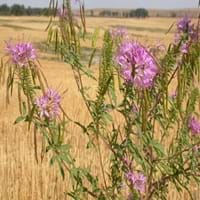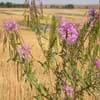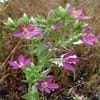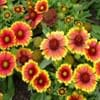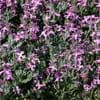Life Span
Annual
Perennial
Type
Herbs, Vegetable
Flowering Plants, Shrubs
Origin
South America, Argentina, Brazil
Africa, America, Asia
Types
Skunk weed, Navajo spinach
Lockinch, Petite Indigo, White Profusion
Number of Varieties
Not Available
Habitat
foothill woods, open Woodlands, Prairies, Roadsides
Along Railroads, River side, Roadsides
USDA Hardiness Zone
3-10
5-10
Sunset Zone
1a, 1b, 2a, 2b, 3a, 3b, 4, 5, 6, 7, 8, 9, 10, 11, 12, 13, 14, 15, 16, 17, 18, 19, 20, 21, 22, 24
H1, 2a, 2b, 3a, 3b, 4, 5, 6, 7, 8, 9, 10, 11, 12, 13, 14, 15, 16, 17, 18, 19, 20, 21, 22, 23, 24
Habit
Upright/Erect
Arching/Fountain-shaped
Flower Color
White
Blue, Pink, Purple, Red, White
Flower Color Modifier
Bicolor
Not Available
Fruit Color
Green
Not Available
Leaf Color in Spring
Green
Gray Green
Leaf Color in Summer
Green
Gray Green, Light Green
Leaf Color in Fall
Green
Gray Green, Light Green, Yellow green
Leaf Color in Winter
Light Green
Not Available
Leaf Shape
Small elliptic
Egg-shaped
Plant Season
Summer
Fall, Spring, Summer, Winter
Sunlight
Full Sun
Full Sun, Part sun, Partial shade
Type of Soil
Sand
Loamy, Sandy, Well drained
The pH of Soil
Acidic, Neutral
Neutral, Slightly Acidic, Slightly Alkaline
Soil Drainage
Well drained
Well drained
Bloom Time
Summer, Late Summer
Spring
Tolerances
Cold climate
Drought, Pollution, Salt, Soil Compaction
Where to Plant?
Container, Ground
Ground, Pot
How to Plant?
Seedlings
Seedlings, Stem Planting, Transplanting
Plant Maintenance
Low
Medium
Watering Requirements
Medium, Requires regular watering, Requires watering in the growing season, Water occasionally
Form a Soil ring to water efficiently, Water Deeply, Water twice a day in the initial period
In Summer
Lots of watering
Lots of watering
In Spring
Moderate
Moderate
In Winter
Average Water
Average Water
Soil pH
Neutral, Slightly Acidic
Neutral, Slightly Acidic, Slightly Alkaline
Soil Type
Sandy, Well drained
Loamy, Sandy, Well drained
Soil Drainage Capacity
Sandy, Well drained
Well drained
Sun Exposure
Full Sun
Full Sun, Part sun, Partial shade
Pruning
Remove damaged leaves, Remove dead or diseased plant parts
Cut or pinch the stems, Prune for shortening long shoots, Prune if you want to improve plant shape, Prune ocassionally, Remove damaged leaves, Remove dead or diseased plant parts, Remove deadheads, Remove shoots
Fertilizers
All-Purpose Liquid Fertilizer, fertilize in growing season
All-Purpose Liquid Fertilizer
Pests and Diseases
Insects, Leaf spot
Downy mildew, Leaf spot, Spider mites
Plant Tolerance
Cold climate
Drought
Flower Petal Number
Single
Single
Fragrant Bark/Stem
Yes
No
Foliage Texture
Medium
Medium
Foliage Sheen
Matte
Matte
Invasive
Sometimes
Sometimes
Attracts
Bees, Butterflies
Butterflies, Hummingbirds
Allergy
Not Available
Vomiting
Aesthetic Uses
Landscape Designing
Showy Purposes
Beauty Benefits
Not Available
Not Available
Environmental Uses
Air purification, Food for insects, Shelter for wildlife
Air purification
Medicinal Uses
Fever
Not Available
Part of Plant Used
Flowers, Leaves, Seeds
Flowers, Leaves
Other Uses
Decoration Purposes, Making deodorants, Used as a dye, Used As Food, Used for its medicinal properties
Showy Purposes, Used as Ornamental plant
Used As Indoor Plant
Yes
No
Used As Outdoor Plant
Yes
Yes
Garden Design
Edible, Herb
Edging, Feature Plant, Foundation
Botanical Name
CLEOME hassleriana 'Helen Campbell'
Buddleia davidii
Common Name
Cleome, Spider Flower
Butterfly Bush, Summer Lilac, Butterflybush
In Hindi
Cleome serrulata
Butterfly Bush
In German
Cleome serrulata
Schmetterlingsstrauch
In French
Cleome serrulata
buisson de papillon
In Spanish
serrulata cleome
arbusto de las mariposas
In Greek
Cleome serrulata
Butterfly Μπους
In Portuguese
serrulata Cleome
arbusto de borboleta
In Polish
cleome serrulata
Butterfly Bush
In Latin
Cleome serrulata
papilio rubo
Phylum
Magnoliophyta
Spermatophyta
Class
Magnoliopsida
Dicotyledonae
Order
Brassicales
Lamiales
Family
Cleomaceae
Scrophulariaceae
Clade
Angiosperms, Eudicots, Rosids
Angiosperms, Asterids, Eudicots
Tribe
Not Available
Not Available
Subfamily
Not Available
Not Available
Number of Species
Not Available
Season and Care of Cleome serrulata and Butterfly Bush
Season and care of Cleome serrulata and Butterfly Bush is important to know. While considering everything about Cleome serrulata and Butterfly Bush Care, growing season is an essential factor. Cleome serrulata season is Summer and Butterfly Bush season is Summer. The type of soil for Cleome serrulata is Sand and for Butterfly Bush is Loamy, Sandy, Well drained while the PH of soil for Cleome serrulata is Acidic, Neutral and for Butterfly Bush is Neutral, Slightly Acidic, Slightly Alkaline.
Cleome serrulata and Butterfly Bush Physical Information
Cleome serrulata and Butterfly Bush physical information is very important for comparison. Cleome serrulata height is 120.00 cm and width 120.00 cm whereas Butterfly Bush height is 7.50 cm and width 4.00 cm. The color specification of Cleome serrulata and Butterfly Bush are as follows:
Cleome serrulata flower color: White
Cleome serrulata leaf color: Green
Butterfly Bush flower color: Blue, Pink, Purple, Red and White
- Butterfly Bush leaf color: Gray Green
Care of Cleome serrulata and Butterfly Bush
Care of Cleome serrulata and Butterfly Bush include pruning, fertilizers, watering etc. Cleome serrulata pruning is done Remove damaged leaves and Remove dead or diseased plant parts and Butterfly Bush pruning is done Cut or pinch the stems, Prune for shortening long shoots, Prune if you want to improve plant shape, Prune ocassionally, Remove damaged leaves, Remove dead or diseased plant parts, Remove deadheads and Remove shoots. In summer Cleome serrulata needs Lots of watering and in winter, it needs Average Water. Whereas, in summer Butterfly Bush needs Lots of watering and in winter, it needs Average Water.
